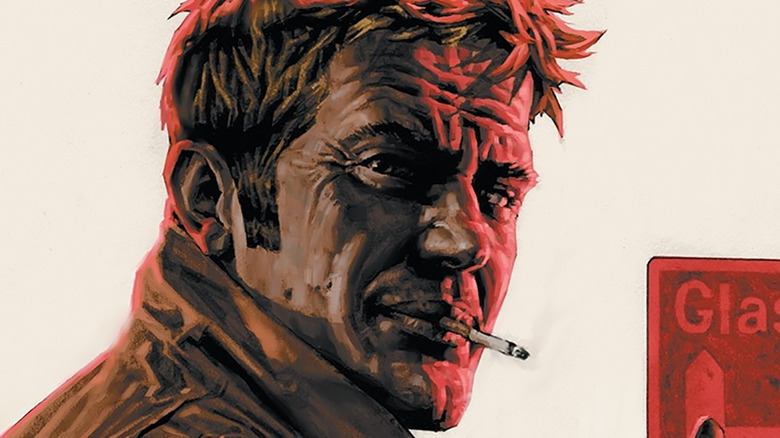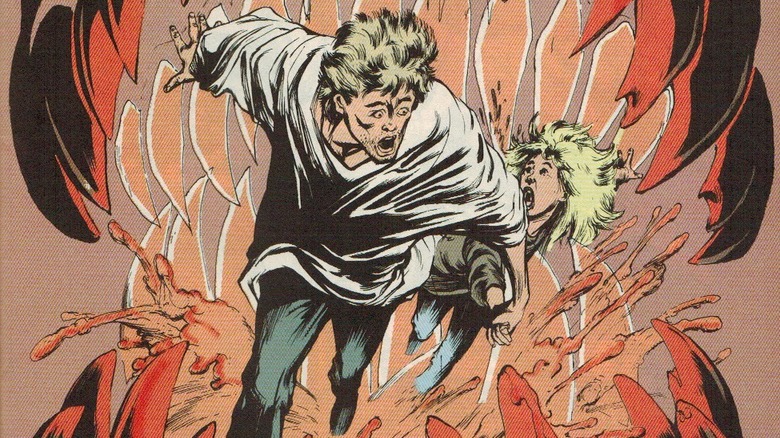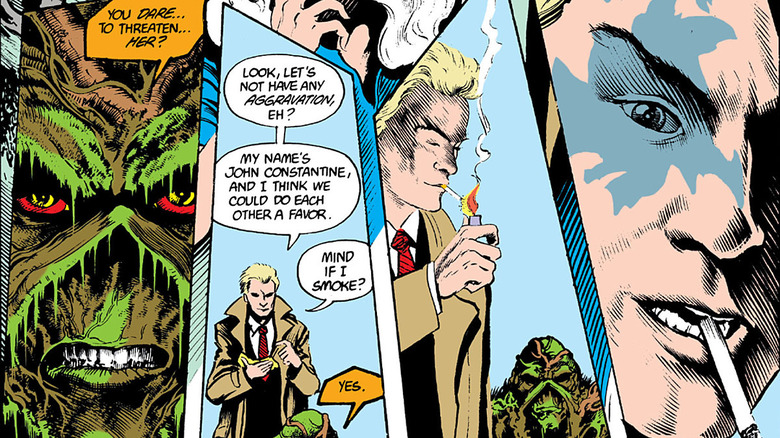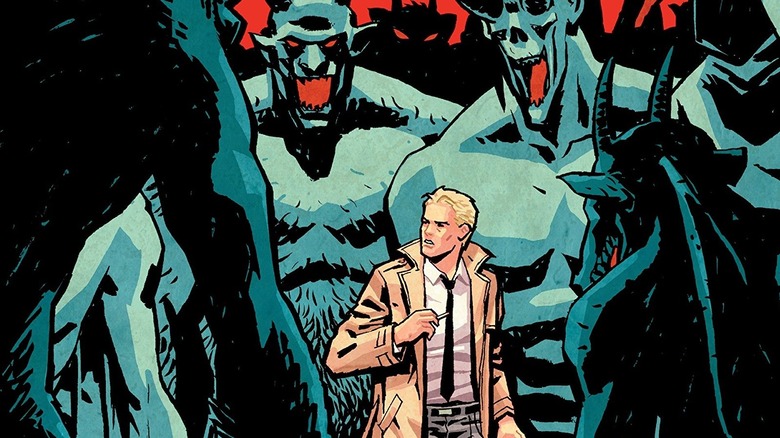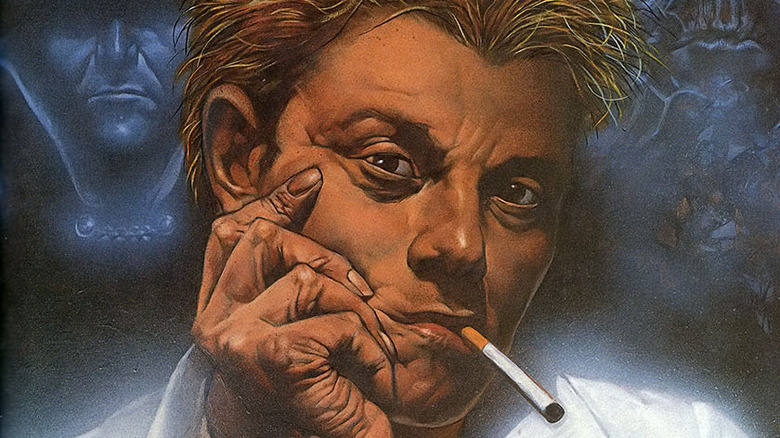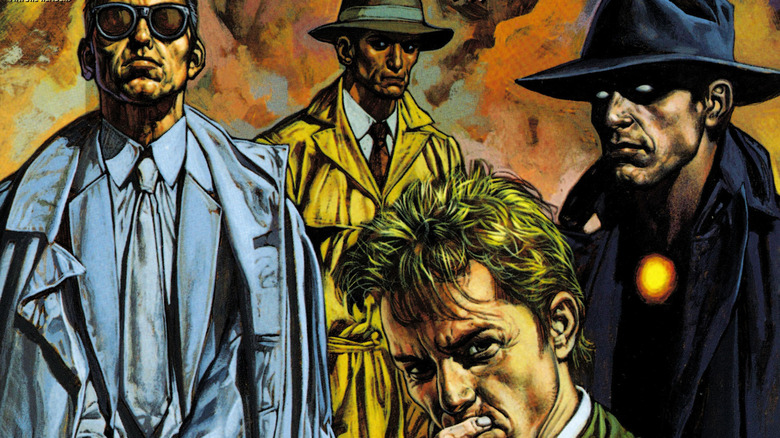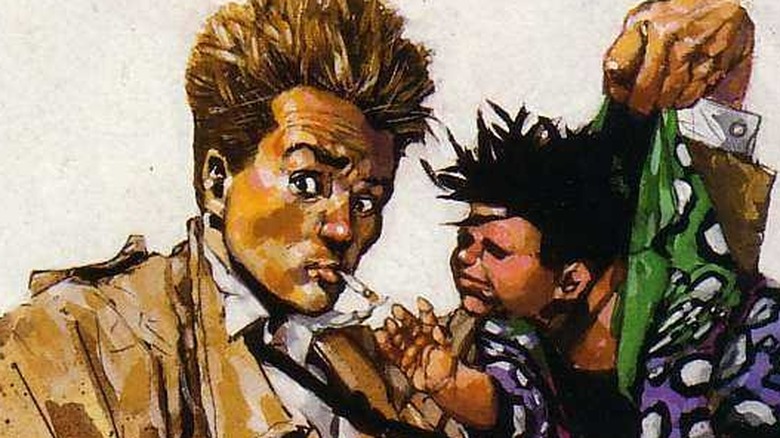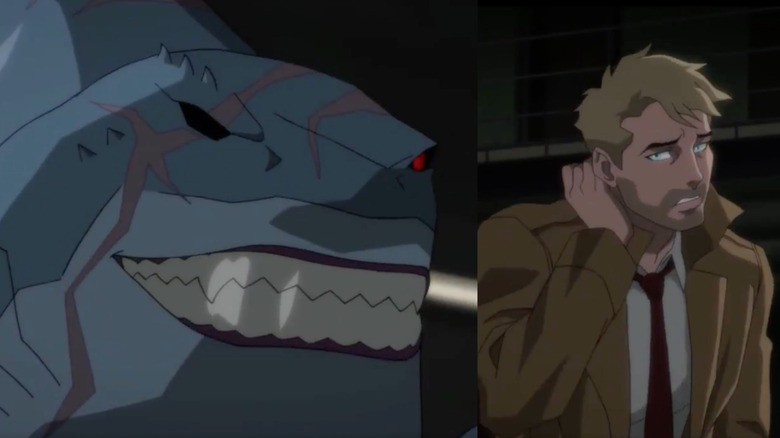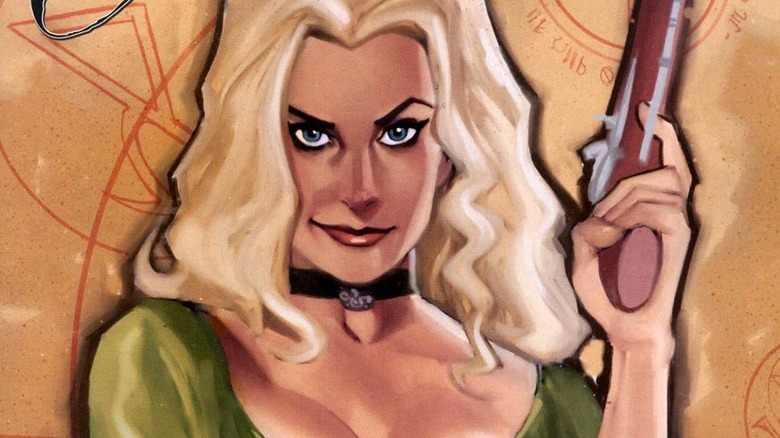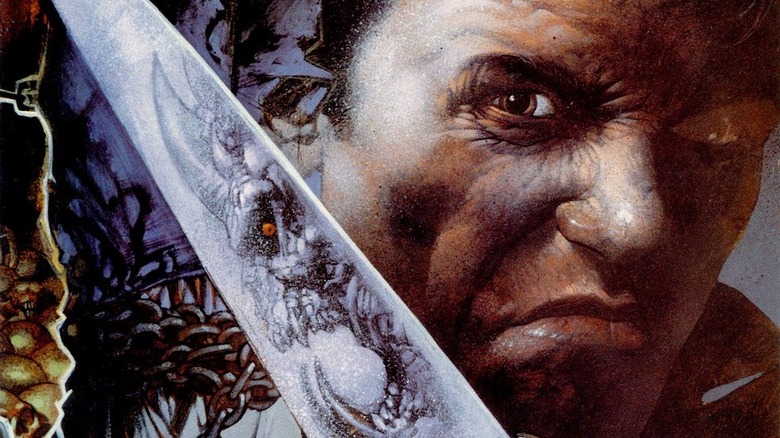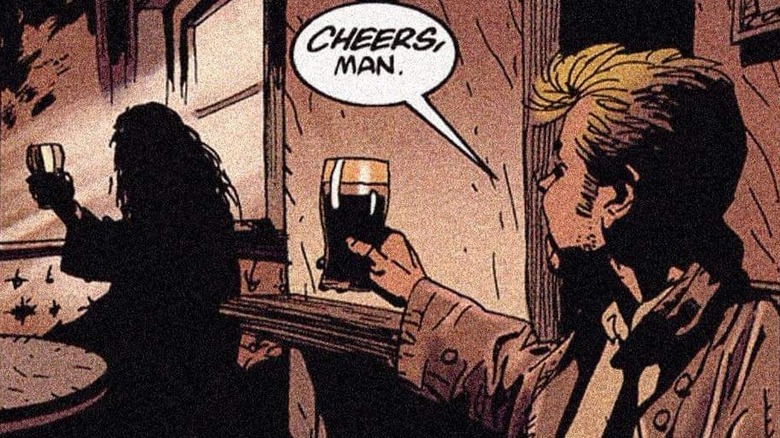10 Things You Didn't Know About John Constantine
John Constantine has been everywhere. Keanu Reeves played him on the big screen in 2005, after starring as Neo in "The Matrix" in 1999, but before "John Wick" in 2014. He co-starred with Bruce Wayne's censored genitals in the three-issue "Batman: Damned" miniseries, and with the Joker's disembodied head in 2020's "Batman: Last Knight on Earth" graphic novel. He appeared as an Allied spy who gets transformed into the magician Zatanna's rabbit in issues of "DC Comics Bombshells" and "Bombshells United." He even inspired the wardrobe of the angel Castiel on the "Supernatural" TV series, according to creator Eric Kripke, but his appearances in the comics have seen his initially stylish suits give way to rumpled shirtsleeves.
Constantine was introduced as a mystical con man who exercised a subtle sleight-of-hand with the supernatural, but in stories such as 2017's "Justice League Dark" film, he's a spell-slinging, card-carrying Justice League member. In DC Comics' "Trinity War" crossover, he steals the power of the superhero Shazam.
Basically, Constantine has changed a lot over the years. Each one of John Constantine's writers have introduced their own circles of friends for him, because it's a safe bet that most of those friends will be dead, or subjected to fates worse than death, by the time those writers are done. Let's learn more about the man whose solo series was going to be called "Hellraiser," until a certain horror film written and directed by Clive Barker snatched that title in 1987.
He seduced a monkey
John Constantine was born in Liverpool on May 10, 1953, after strangling his twin brother with his umbilical cord in the womb. In a parallel universe, John's twin survived to become the successful and functional adult magician that John could never be. Growing up with an alcoholic, abusive, widowed father, John left home to form the punk rock band Mucous Membrane. His roadie, Francis "Chas" Chandler (nicknamed after the bassist for The Animals), would become John's closest, oldest, and only surviving friend, after John freed Chas from the clutches of his mother, a possessive witch whose familiar was not a black cat, but a chimpanzee dressed as a woman.
After John killed Chas' mother by pretending to romance, then murdering, her monkey familiar, he became involved enough in the occult that he tried to free a child, Astra Logue, from the monster she'd conjured to take revenge on the adults who were abusing her. John summoned the demon Nergal to destroy the monster, but because John failed to bind him, Nergal took Astra with him to Hell. John suffered a nervous breakdown, and was committed to a psychiatric asylum called Ravenscar, to which he returned periodically over the years.
While Constantine was able to free Astra years later, along with the souls of all the other children trapped in Hell, the Newcastle Crew who'd aided him remained among the earliest of his countless friends forced to pay for his sins.
He is the father of Swamp Thing's child (sort of)
John Constantine made his official debut in "Swamp Thing" #37 in June of 1985, after artists Steve Bissette and John Totleben, both fans of the Police, told writer Alan Moore they wanted to draw a character who looked like Sting. They'd already drawn a T-shirt-clad Sting lookalike as a single-panel background character in "The Saga of Swamp Thing" #25, who was retroactively declared to be John Constantine.
But the Constantine who introduced himself to the Swamp Thing and his human lover, Abigail "Abby" Arcane, was a more sharp-dressed man, wearing his signature trench coat and smoking what would later be identified as Silk Cut cigarettes, his favorite brand. Constantine's introductory story arc, which ran through "Swamp Thing" #49, saw the surviving members of the Newcastle Crew wiped out by an apocalyptic cult, including John's lover at the time, an American artist named Emma. At the same time, John gained a grudging ally in the Swamp Thing, and eventually served as the biological father for the daughter of the Swamp Thing and Abigail Arcane, a human-plant hybrid named Tefé Holland.
After he was spun off into his own title with "John Constantine: Hellblazer" #1 in January of 1988, writer Jamie Delano brought back the ghosts of the Newcastle Crew in "John Constantine: Hellblazer" #9 to bid John a bittersweet 35th birthday.
Demon blood runs through John Constantine's veins
Nergal returned to John's life when the demon needed the magician to do his bidding on a deadline, but John was hospitalized with extensive injuries, so Nergal healed him with a transfusion of his own demon blood in "Hellblazer" #8.
John's demon blood proved to have both healing and age-extending properties, in addition to being corrosive and poisonous to others — seen when he was attacked by the King of the Vampires in "Hellblazer" #69, among other times — but John received the most ironic boost to his medical health in "Hellblazer" #41 through #46. Writer Garth Ennis opened his "Dangerous Habits" arc by delivering a terminal lung cancer diagnosis to chain-smoker John Constantine, who already knew he was damned to Hell.
So, just before John's illness progressed to the point that Satan came to collect, John also sold his soul to the other two, equally powerful lords of Hell's triumvirate, forcing them to cure his cancer so they wouldn't be forced to go to war to settle who owned his soul. John escaped Hell's clutches again in writer Paul Jenkins' "Critical Mass" story arc in "Hellblazer" #92 through #96, by using Nergal's demon blood to siphon off the worst parts of his personality into a separate soul that Satan could finally collect.
For years, Constantine aged in real time
Unusually for characters in shared superhero universes, John Constantine aged in real time from his 1985 debut in "Swamp Thing" through the conclusion of "Hellblazer" (vol. 1) #300, in April of 2013. The four-issue "Hellblazer Special: Bad Blood" miniseries, written by returning writer Jamie Delano and published between September and December of 2000, was set in the then-far-future year of 2025, and preemptively served as a postscript to this version of the character, focusing on a 72-year-old John Constantine whose unborn child potentially stood to inherit the British throne.
In addition to Delano, writer Garth Ennis foregrounded Constantine's age in March 1993's "Hellblazer" #63 by having John's friends celebrate his 40th birthday. Highlights of the festivities include a visiting Swamp Thing using his powers over plants to transform a weak pot plant into a mighty marijuana bush, which John and fellow magician Zatanna Zatara smoke to get high, and John drunkenly peeing on the shoes of a briefly materializing Phantom Stranger, who's so embarrassed that he immediately disappears again.
Given that "Hellblazer" #63 was the title's first official issue under DC's Vertigo imprint, it's amusing that Ennis chose to play up Constantine's connections to established DC superheroes like his ex-lover Zatanna, one of the more well-known members of the Justice League, and the Phantom Stranger, who shares membership in the Trenchcoat Brigade alongside John.
He's Neil Gaiman's go-to Vertigo guest star
John Constantine was a relative latecomer to the DC Vertigo label, but he pitched in for a few of his fellow characters in the line, especially those written by Neil Gaiman. After Gaiman's "Sandman" #1 premiered in January of 1989, John Constantine put in an appearance in "Dream a Little Dream of Me" in "Sandman" #3, which saw him help Dream of the Endless recover his sand pouch, with long-suffering cabbie Chas Chandler giving a lift to both his buddy John and the intimidating Lord Morpheus.
Gaiman's four-issue "The Books of Magic" miniseries, which ran from December of 1990 through March of 1991, branded a handful of DC Comics' magic-users as "the Trenchcoat Brigade" — not only Constantine and the Phantom Stranger, but also Doctor Occult and Mister E — and introduced Timothy Hunter, an adolescent, bespectacled British boy coping with his destiny of becoming a great magician (sound familiar?).
John Constantine's unlikely role of mentoring '90s youth extended to a Gaiman-written PSA mini-comic, "Death Talks About Life," published in "Hellblazer" #62, "Sandman" #46 and fellow DC Vertigo title "Shade the Changing Man" #32. Dream's older sister, Death of the Endless, talks about HIV and AIDS, including how they're contracted and how to minimize one's exposure, then calls on a surprisingly sheepish John to demonstrate how to put on a condom, using a banana as a prop.
John gets around with both guys and gals
Any character co-created by artists who wanted to draw Sting in his prime is going to appeal to men and women alike. Not only did John romance Zatanna, but "Justice League Dark" #12 introduced Nicolas Nolan, aka Nick Necro, the sorcerer ex-boyfriend of both Zatanna and John. The "History Lesson" story arc of "Shade the Changing Man" transported a Ravenscar-era John Constantine forward in time to fall in love with Kathy George, the intermittent love interest of Rac Shade, a reality-altering alien who, like Zatanna, teamed up with Constantine in "Justice League Dark" #1.
In "Hellblazer" #104, published in August of 1996, John slept with the succubus Chantinelle to restore his internal balance of good versus evil after he'd exorcised the bad parts of himself into his demonic Constantine substitute. In "Bad Blood," John learns that his much younger friend, Daljit "Dolly" Smith, is heir to the British royal family after he has a drunken one-night stand with her. Even when John marries a much-younger mobster's daughter, Epiphany Greaves, near the end of his original "Hellblazer" run, it's not without complications, as John sends her to Rac Shade to protect her from his magical curse-induced rages. Shade, thinking romantic turnabout is fair play, gives Epiphany the face of Kathy George, then sends her back in time after she rejects his advances.
Seriously, Constantine is not straight
The irony of Matt Ryan's nearly seven-year stint playing John Constantine is that NBC forbade even a hint of the character's bisexuality from appearing in his initial 13-episode TV series, which ran from October of 2014 through February of 2015, even though he's alluded to as having "girlfriends (and) the odd boyfriend" as far back as "Hellblazer" #51 in March of 1992.
And yet, Ryan's subsequent live-action and animated performances have addressed Constantine's sexuality, from having him hit on gay hero Leo Snart in the "DC's Legends of Tomorrow" episode "Daddy Darhkest" to mentioning "my ex" in the May 2020 "Justice League Dark: Apokolips War" animated film, before a wink and a toothy grin from the humanoid Killer Shark confirms that it isn't Harley Quinn that John's referring to ("Do I look mad?" John asks, when it's assumed he meant Harley). After a fourth season of "Legends of Tomorrow" featured John fighting to save his ex-lover Desmond from the demon Neron, the "Crisis on Infinite Earths" crossover saw John flirting with Tom Ellis' Lucifer.
It's a shame that Ryan won't be returning for the upcoming "Constantine" series on HBO Max. In the meantime, fans of controversial storylines can raid their back issues for John's love-hate relationship with Bruce Wayne stand-in S.W. "Stanley" Manor (as in, "Stately Wayne Manor"), which ran through "Hellblazer" #162 through #174.
He comes from a long line of talented magicians
Netflix's upcoming "The Sandman" TV series, based on Neil Gaiman's comic of the same name, will introduce former "Doctor Who" companion Jenna Coleman as another of Gaiman's creations: Lady Johanna Constantine, an 18th century aristocrat, adventurer, and ancestor of John Constantine who also dabbled as an occult detective.
Not everyone in the Constantine family has an affinity for magic, but those in the bloodline who can outwit and defy higher powers are known as "the Laughing Magicians," and include not only John and Johanna Constantine, but also Kon-stan-tyn of 400 A.D., the king of England after Arthur's death, and Emperor Constantine of 500 A.D., who converted Rome to Christianity.
Paul Jenkins introduced James Constantine in "Hellblazer" #106 as the drug supplier of Samuel Taylor Coleridge and the unidentified "person from Porlock" whose visit interrupted Coleridge's composition of the poem "Kubla Khan" in 1797, thereby preventing it from being completed. Even John's niece, Gemma Masters, grew into a capable magician, in spite of John's brother-in-law being a devout Christian.
John's supernatural offspring include artificially aged triplets Adam, Maria and Saul Constantine, created by the demon Rosacarnis during writer Mike Carey's "Hellblazer" run, and Dane Constantine, introduced in "Trinity of Sin: Pandora" #9 as John's biological clone, co-created by Nick Necro and Felix Faust.
Many of Constantine's writers have created their own versions of the character
One interesting trend among "Hellblazer" writers: They also create their own takes on the character. Constantine inspired Mike Carey, who wrote "Hellblazer" issues #175-215, to create London "freelance exorcist" Felix Castor, star of five novels between 2006 and 2009, the first of which, "The Devil You Know," shares its title with "Hellblazer" #12.
Carey was emulating examples such as Grant Morrison, who wrote "Hellblazer" #25 and #26 before featuring Constantine in a dream sequence in "Doom Patrol" #53 in March of 1992. However, DC Comics' editorial prohibitions had already inspired Morrison to introduce a stand-in English magician named Willoughby Kipling in "Doom Patrol" #31, whom Mark Sheppard played in the first two seasons of the "Doom Patrol" TV series.
Similarly, Warren Ellis, who wrote "Hellblazer" #134 through #143, was inspired by Constantine to feature a chain-smoking, trenchcoat-wearing, British blonde occult detective named Constance Johanssen in his 1996 three-part "Pryde & Wisdom" Marvel Comics miniseries. Ellis also introduced Jack Carter in issue #7 of his "Planetary" series, only to have him shave his head, ditch his trench coat, and adopt the appearance of Spider Jerusalem, the protagonist of Ellis' 60-issue "Transmetropolitan" series. Curiously, Ellis' infamously banned "Shoot" story for "Hellblazer," scheduled to run in issue #141, barely features Constantine at all, serving instead as a polemic on school shootings, which got the story canceled after the Columbine High School massacre that year.
Intended Constantine appearances in 1993's four-issue "Stanley and His Monster" miniseries, and in issues of "Firestorm" and "Captain Atom" from 1989, 1990 and 1991, were replaced by characters named Ambrose Bierce (whose resemblance to Constantine is a running gag) and "Gregori Eilovotich Rasputin," respectively.
John Constantine might exist in real life
Three "Hellblazer" writers claim to have seen John Constantine in real life, while his co-creator allegedly met him twice.
Jamie Delano told Vulture in 2014 he saw Constantine near the British Museum early in his original run on "Hellblazer," and said Constantine "cocked his head, flicked the ash from a ciggie, and continued without stopping." Delano opted not to follow, because "what the f*** would I say? And what trouble might one get into?" That article also reports that Peter Milligan sighted Constantine at a party around 2009, and pursued him to find he'd disappeared, while Brian Azzarello spotted him in a Chicago bar in the early 2000s, but avoided him because "the last thing you'd want to be is [John's] friend."
Alan Moore told Wizard in 1993 that he was sitting in a bar in London, not long after the character first appeared in the comics, when Constantine walked in, wearing his trench coat. "He didn't even look exactly like Sting. He looked exactly like John Constantine," Moore said. According to Moore, Constantine "stared me straight in the eyes, smiled, nodded almost conspiratorially, and then just walked off," leaving Moore to wonder, like Delano, if he should follow to confirm Constantine's existence, before he left instead, deeming it "safest." Eddie Campbell's 2001 comic adaptation of Moore's 1999 spoken word performance "Snakes & Ladders" recorded another of Moore's encounters with Constantine, who supposedly whispered, "I'll tell you the ultimate secret of magic. Any c*** could do it."
